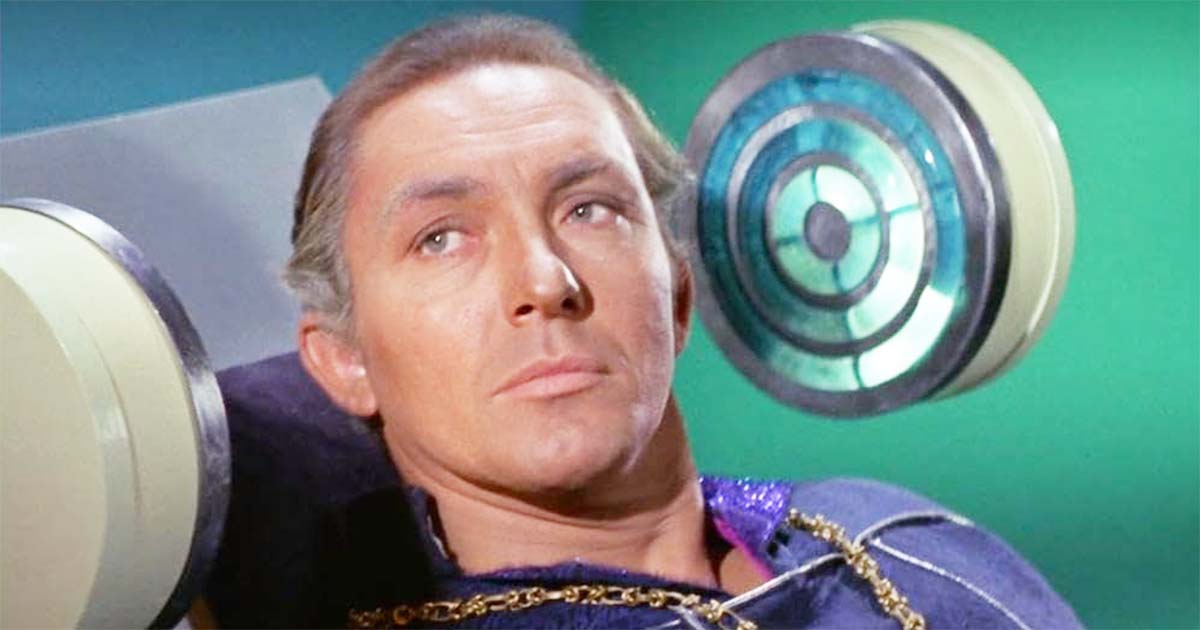Madness and Tyranny in "Whom Gods Destroy"
Explore the psychological and moral themes in the banned "Star Trek" episode "Whom Gods Destroy," where madness and power collide in a story of tyranny, trauma, and redemption.

"Star Trek: The Original Series" often dared to explore humanity's darkest fears and ambitions. In "Whom Gods Destroy," the show confronted the complex intersection of madness and power, presenting a story that proved too unsettling for its time.
Banned by the BBC for more than two decades, this episode challenged perceptions of mental illness, leadership, and identity through a harrowing narrative of psychological manipulation and tyranny.
Why did this episode provoke such a strong reaction? To answer that, we must journey to the eerie corridors of Elba II and the mind of a once-great man consumed by madness.
A World of Madness and Control
The "Enterprise" arrives at Elba II, a high-security facility for the criminally insane, to deliver a medical breakthrough that could cure mental illness. Captain Kirk and Spock expect a routine mission but are instead trapped by Garth of Izar, a legendary former Starfleet captain who has seized control of the asylum.
Garth's story is one of tragic downfall. Once revered for his brilliance and bravery, he suffered a psychological break after enduring traumatic injuries and isolation. Now delusional, he believes himself a god destined to conquer the galaxy. Using shape-shifting powers gained through alien technology, Garth manipulates his captives, subjecting them to both physical and psychological torment.
The asylum's oppressive atmosphere underscores the claustrophobia and fear experienced by Kirk and his crew. With few allies and no clear path to escape, they must confront Garth's fractured psyche while resisting his attempts to dominate and humiliate them.
Madness, Identity, and the Corruption of Power
At its core, "Whom Gods Destroy" is a meditation on the fragility of identity and the corrupting influence of unchecked power. Garth's fall from grace reflects the series' recurring theme that greatness without humility can lead to ruin. His transformation from hero to tyrant is both terrifying and tragic, raising questions about how trauma and isolation can erode even the strongest minds.
The episode also grapples with the ethics of mental illness and rehabilitation. Kirk's interactions with Garth demonstrate the tension between empathy and the need to neutralize a dangerous threat. The story suggests that while some individuals may lose control of their faculties, they deserve dignity and care.
This exploration of power dynamics and mental instability resonated with contemporary anxieties about authority, mental health, and institutional responsibility. However, the intensity of the narrative proved too much for certain audiences.
Protecting Audiences from Depictions of Insanity
The BBC's decision to ban "Whom Gods Destroy" was rooted in concerns over its portrayal of madness and sadism. Viewer complaints highlighted the disturbing scenes of psychological manipulation and violence, particularly Garth's erratic behavior and his demeaning treatment of both Kirk and Marta, an inmate who becomes a pawn in his schemes.
Unlike episodes that relied on graphic physical violence, "Whom Gods Destroy" unsettled audiences through its depiction of mental instability and emotional trauma. The unpredictable shifts in Garth's demeanor—from charming to violently unhinged—created a sense of unease that lingered long after the episode ended.
As societal attitudes toward mental health evolved, so too did perceptions of media representation. By the 1990s, the BBC lifted the ban, recognizing that audiences had grown more accustomed to stories exploring psychological complexity and moral ambiguity.
The Line Between Horror and Commentary
"Whom Gods Destroy" joined other banned Star Trek episodes in pushing the boundaries of what television could depict. Episodes like "The Empath" and "Plato's Stepchildren" also faced censorship for their intense portrayals of suffering and humiliation. However, each episode approached these themes in distinct ways.
In contrast to the minimalism of "The Empath," which relied on atmosphere and implication, "Whom Gods Destroy" used vivid character dynamics to convey its horror. Garth's descent into madness was central to the episode's tension, making the psychological stakes more immediate and visceral.
The episode's exploration of mental illness also aligns with broader science fiction traditions that examine identity and human vulnerability. Stories of fractured minds often serve as metaphors for societal fears, reflecting both the stigma surrounding mental health and the hope for healing.
An Image for Its Time
The 1960s were a period of profound social change, marked by shifting attitudes toward authority, mental health, and institutional care. Deinstitutionalization efforts sought to improve treatment for those with mental illnesses, but they also exposed deep anxieties about how society should care for its most vulnerable members.
"Whom Gods Destroy" reflected these concerns through its portrayal of Garth and the inmates of Elba II. The episode's dark portrayal of madness resonated with fears about the abuse of power and the fragility of leadership. At the same time, it raised uncomfortable questions about whether individuals who lose their sense of reality can ever regain their humanity.
The use of a former Starfleet captain as the antagonist heightened the story's impact. Garth's tragic arc served as a cautionary tale about the thin line between greatness and hubris—a theme that echoed both contemporary political events and timeless philosophical debates.
Why Whom Gods Destroy Still Matters
In spite of the controversy surrounding its original broadcast, "Whom Gods Destroy" remains a thought-provoking entry in the "Star Trek" canon. Its exploration of madness, trauma, and redemption continues to resonate with audiences who grapple with questions of identity and authority.
The episode's depiction of mental illness is particularly relevant in today's discussions about mental health awareness and stigma. Garth's story invites viewers to reflect on how power can be both a source of strength and a pathway to self-destruction.
Moreover, "Whom Gods Destroy" underscores the importance of compassion and empathy. In a world where those in power often face immense psychological strain, the episode reminds us of the need to balance strength with understanding.
A Tale of Lost Greatness and Redemption
"Whom Gods Destroy" exemplifies "Star Trek's" ability to confront difficult social and moral issues through allegory. The BBC's ban highlighted the episode's power to provoke reflection on uncomfortable truths about human nature.
Today, the story endures as both a warning and a testament to the resilience of the human spirit. In a universe where identity and morality are constantly tested, "Whom Gods Destroy" stands as a reminder that even in madness, there is the potential for redemption.

